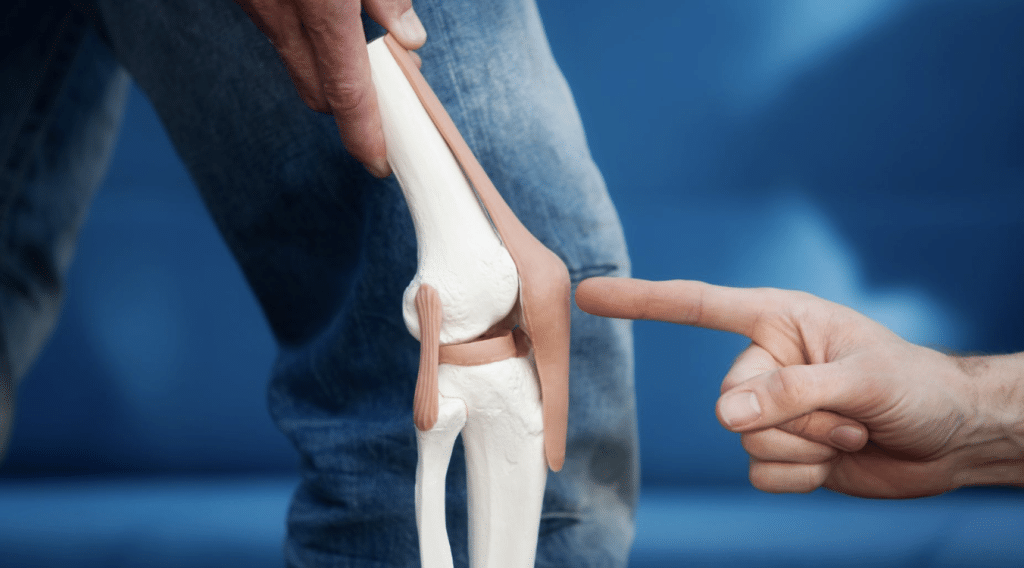Knee osteoarthritis (OA) affects millions worldwide, particularly individuals aged 55 and above. As the protective cartilage wears down, the bone around the joint changes, leading to pain, stiffness, and reduced flexibility. These progressive symptoms impact daily life and necessitate effective treatment options.
Two commonly used injectable treatments for knee osteoarthritis are Durolane and Orthovisc. Both hyaluronic acid-based products relieve pain by lubricating and cushioning the knee joint. However, their formulation, duration of effects, and specific uses differ. Understanding these differences can help patients and healthcare providers make informed decisions.
This article will explore each treatment’s characteristics, benefits, and potential drawbacks. This guide provides comprehensive information to help you make an informed decision.
Key Takeaways
- Durolane is a one-time injection that can relieve knee pain for over a year. It uses non-animal-sourced hyaluronic acid, making it convenient for patients who want fewer doctor visits.
- Orthovisc requires multiple injections (three to four times) and provides relief for up to six months. It comes from rooster combs and has more hyaluronic acid than Durolane.
- Both treatments aim to improve joint lubrication in people with osteoarthritis but differ in treatment approach, relief duration, and cost.
- Durolane and Orthovisc have mild side effects, such as swelling or pain at the injection site. Their safety profiles show that they are generally safe options.
- Cost varies between them; Durolane might be pricier because of its long-lasting effect from a single shot, while Orthovisc requires several injections, which could increase overall cost depending on the number of doses needed.
About: Medical Spa RX provides medical practices with premium products at the best prices. If you’re looking to buy Durolane for your practice, the sales representatives at Medical Spa RX can give you guidance.
Introduction to Durolane and Orthovisc
Osteoarthritis (OA) is a degenerative joint disease characterized by the breakdown of cartilage, leading to pain, stiffness, and reduced mobility. It is the most common form of arthritis, particularly affecting the knees and hips, and significantly impacts the quality of life of millions of people worldwide.
Viscosupplements are injectable treatments that use hyaluronic acid (HA) to alleviate the symptoms of OA. HA is a naturally occurring substance in the joint fluid that provides lubrication and cushioning. Viscosupplements aim to restore these properties, reducing pain and improving joint function. They are a non-surgical option often considered when other treatments, such as physical therapy and pain medications, have not provided sufficient relief.
Durolane and Orthovisc are two prominent viscosupplements used to treat OA. Durolane features a high-molecular-weight HA designed for single-injection treatment, while Orthovisc consists of multiple lower-molecular-weight HA injections.
Composition and Mechanism of Action

Durolane comprises high-molecular-weight non-animal-stabilized hyaluronic acid (NASHA). This formulation is designed to closely mimic the natural hyaluronic acid found in joint synovial fluid. Durolane’s high viscosity allows it to provide prolonged lubrication and cushioning within the joint.
When used for conditions like hip osteoarthritis, Durolane hip treatments help reduce friction and absorb shock, alleviating pain and improving joint function. Additionally, Durolane’s single-injection regimen offers convenience and sustained relief from symptoms.
Conversely, Orthovisc is made from ultra-pure, high-molecular-weight hyaluronic acid derived from bacterial fermentation. Unlike Durolane, Orthovisc is administered as a series of three to four weekly injections. Its mechanism of action involves restoring the viscoelastic properties of the synovial fluid. The multiple injections of Orthovisc help maintain consistent levels of hyaluronic acid in the joint, providing ongoing relief and supporting joint health.
Clinical Efficacy and Safety Profiles

Durolane has been demonstrated to provide a greater reduction in knee osteoarthritis (OA) pain compared to Synvisc-One. It offers longer-lasting pain relief than steroid injections and is safe for repeated courses of therapy. Moreover, repeated use of Durolane does not increase the incidence of adverse events
Durolane is generally well-tolerated. Adverse events are minimal and typically related to the injection procedure (e.g., localized pain, swelling). The infection risk is low, and Durolane has been used globally without safety concerns
Meanwhile, Orthovisc provides symptomatic relief in knee OA but may have shorter-lasting effects than Durolane. Studies show variable outcomes, with some patients experiencing significant benefits while others show less response.
Like Durolane, Orthovisc is generally safe. Common adverse effects include transient joint pain and swelling. However, patients with known allergies to hyaluronic acid should avoid Orthovisc.
Specific Benefits and Patient Satisfaction

Durolane’s single 3 mL injection offers simplicity and effectiveness, distinguishing it as a leading option. It differs remarkably from Orthovisc, which mandates numerous instances for a complete treatment cycle. Patients are delighted with Durolane. They find this treatment helpful because it causes less pain than saline injections. Getting relief from a single 3 mL shot adds to their comfort and convenience.
Orthovisc, on the other hand, enters the scene with its unique benefits. This treatment necessitates multiple injections over weeks, offering a steady yet potent approach to managing osteoarthritis. It provides a process suitable for those searching for consolation along a more regulated timeline. The powerful level of hyaluronic acid in Orthovisc distinguishes it, striving to offer superior pain management in contrast with other alternatives.
Orthovisc provides joint lubrication and replenishes synovial fluid, which is essential for fluid movement. Patients often opt for this choice due to its comprehensive strategy to alleviate knee discomfort.
Treatment Protocols and Duration of Relief
Understanding the specific treatment protocols and the duration of relief is crucial for anyone considering or undergoing a rejuvenation procedure. By clearly understanding these aspects, patients can make informed decisions and set realistic expectations for their rejuvenation journey.
- The area around the injection site on the knee is cleaned and disinfected to prevent infection.
- While not always necessary, some patients may require local anesthesia to minimize discomfort during the procedure.
- Avoid heavy activities such as jogging or tennis directly after the injection. Allow the joint to rest.
- Patients are observed briefly post-injection for any immediate reactions and informed about signs of possible complications requiring medical attention.
- A follow-up appointment might be scheduled to assess the treatment’s effectiveness and discuss any concerns.
- Most notably, patients can experience pain relief for over a year after just one treatment, making it an attractive option for the long-term management of osteoarthritis symptoms.
Cost Comparison
- Durolane: Its long-lasting pain relief over a year makes Durolane not just a product but a considerable investment in joint health and patient comfort.
- Orthovisc: The treatment often requires many shots over a few weeks, which can add up in price. The higher hyaluronic acid levels and multiple doses also make Orthovisc pricier. So, choosing Orthovisc might mean spending more because of its treatment plan for knee joint pain relief from osteoarthritis.
Each injection adds to the total cost patients pay for relief. Since Orthovisc is used in several sessions, the costs are not just for the medicine but also for each visit to the doctor.
Conclusion
Choosing between Durolane and Orthovisc depends on a patient’s needs. Each treatment makes knee joints work better, feel less pain, and move more smoothly.
Doctors look at many things before suggesting one over the other. It’s all about giving knees the best care possible. So, finding the right option matters for keeping those steps comfortable and steady.
FAQs
1. What are Durolane and Orthovisc?
Durolane and Orthovisc are two medical treatments used to relieve joint pain. A healthcare professional injects them directly into the affected area.
2. How do Durolane and Orthovisc work?
Both Durolane and Orthovisc work by replenishing natural fluids in your joints that may have been lost due to age or injury, helping to reduce friction, ease pain, and improve mobility.
3. Are there any differences between Durolane and Orthovisc?
Yes, there are differences between these two treatments, such as their formulation, treatment protocol, cost, and potential side effects, which should be considered when deciding to use them for joint pain relief.
4. Which is better – Durolane or Orthovisc?
The effectiveness of either treatment can vary depending on individual factors, such as the severity of your condition or how well you respond to injections. Discussing these options with your doctor, who can guide you based on your specific needs, is best.
References
Yoshimura, N., Muraki, S., Oka, H., et al. (2009). Prevalence of knee osteoarthritis, lumbar spondylosis, and osteoporosis in Japanese men and women: The research on osteoarthritis/osteoporosis against disability study. Journal of Bone and Mineral Metabolism, 27(5), 620–628. https://doi.org/10.1007/s00774-009-0080-8
Centers for Disease Control and Prevention. (2020). Osteoarthritis. Retrieved from https://www.cdc.gov/arthritis/basics/osteoarthritis.htm
Mavrogenis, A. F., Mauffrey, C., Karampinas, P. K., & Scarlat, M. M. (2021). A comprehensive review of viscosupplementation in osteoarthritis of the knee. Orthopedic Reviews, 13(2), 25549. https://orthopedicreviews.openmedicalpublishing.org/article/25549-a-comprehensive-review-of-viscosupplementation-in-osteoarthritis-of-the-knee





















